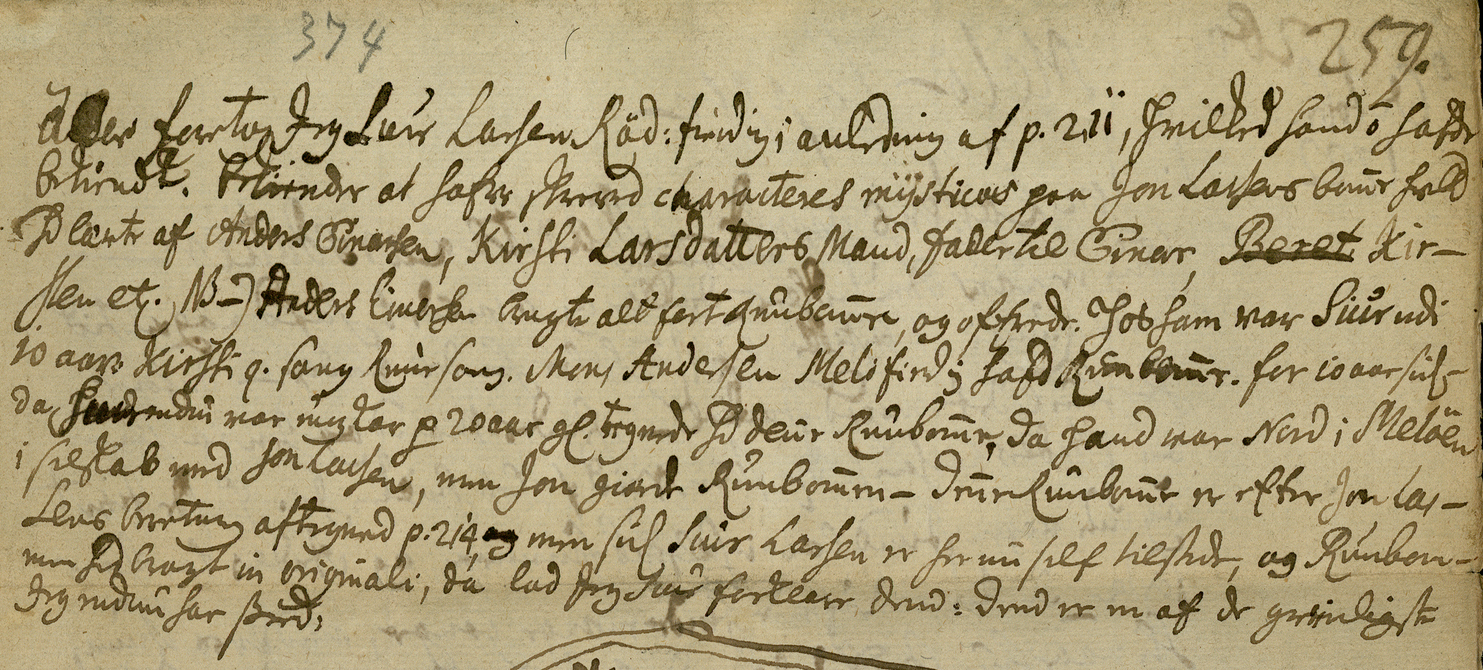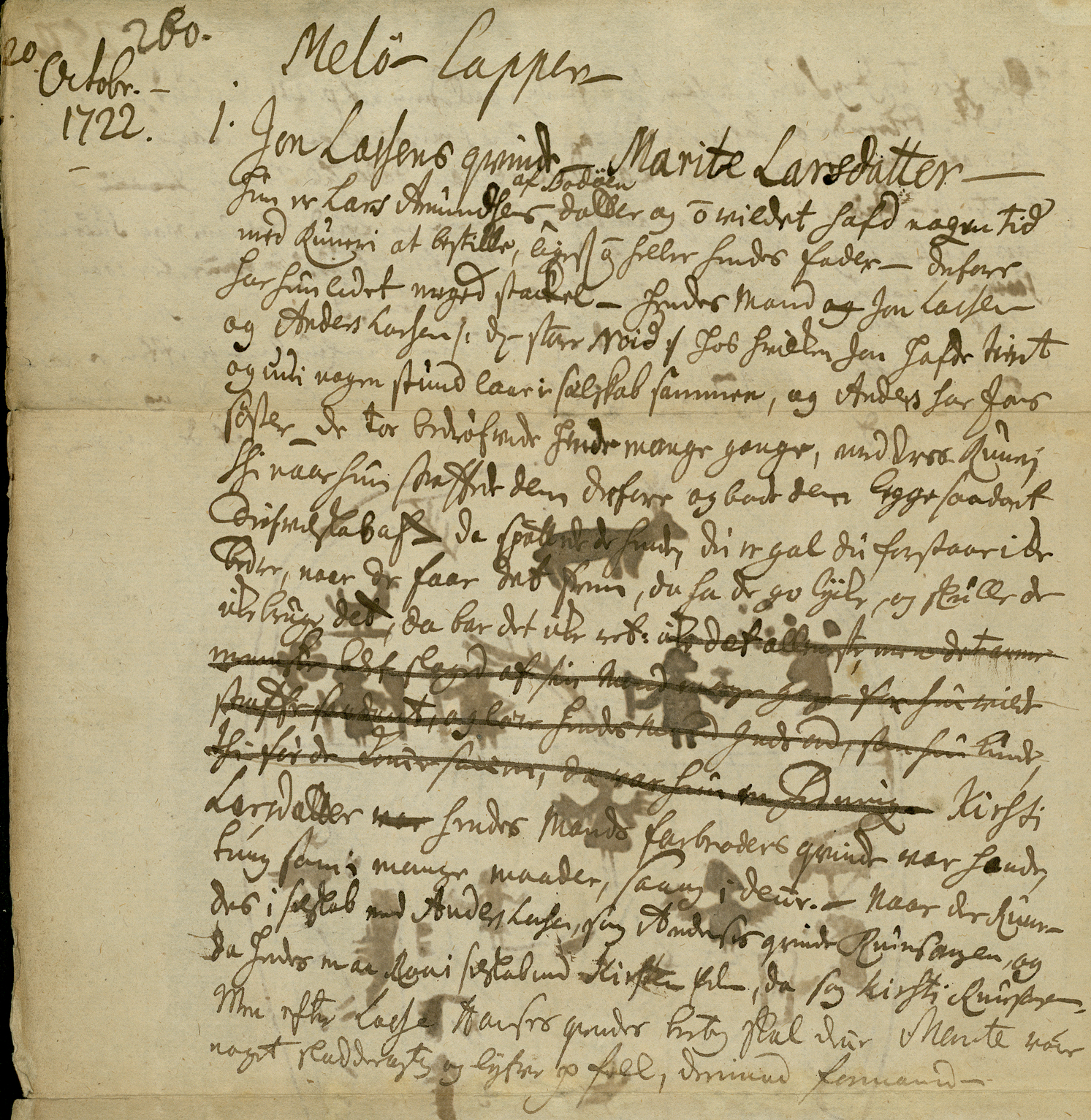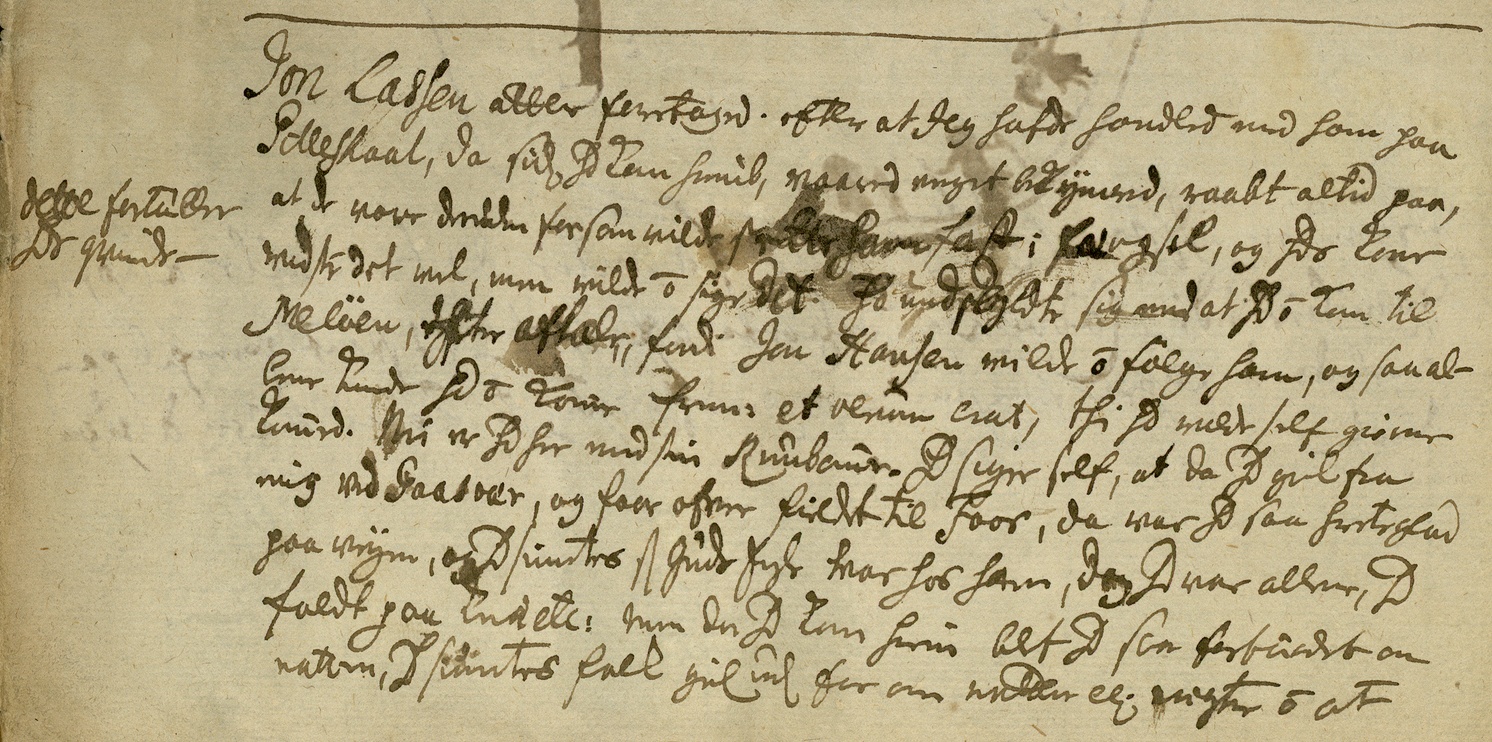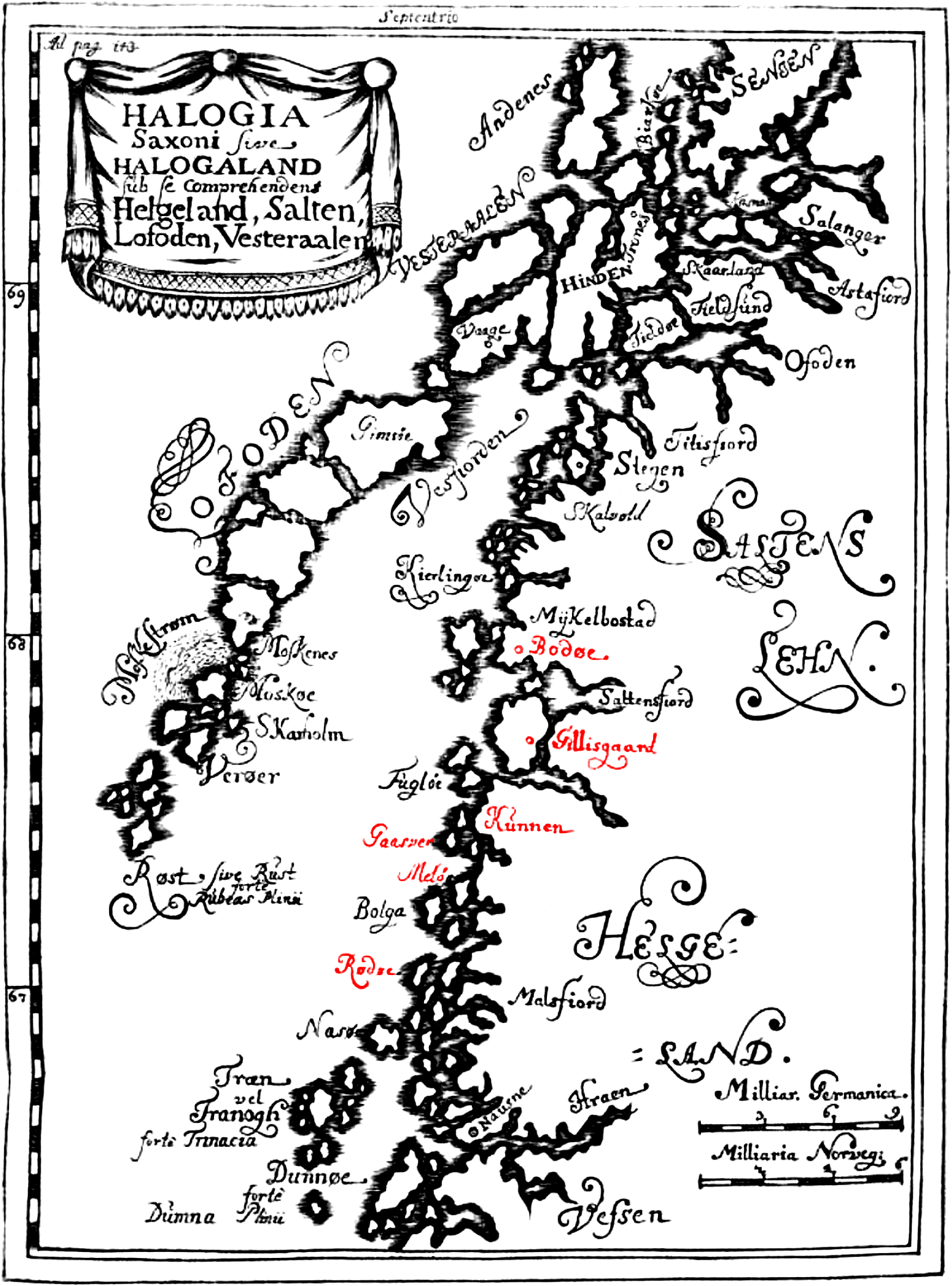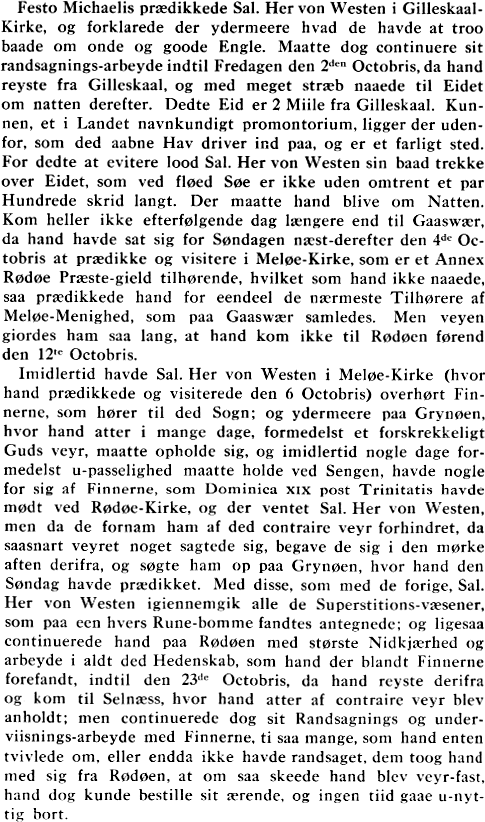Jon Lassen’s Ume Sámi drum, made c. 1712
The fragment of Thomas von Westen’s interrogation protocol
The interrogation protocol is rapidly and at times carelessly written, but maintains the contrast between Kurrent-script for the main text and a more readable Roman cursive for various forms of empasis, such as headings, Latin terms, and both personal and place names. This mimics the distinction between blackletter and antiqua in print and is common in handwriting in this period; I maintain the contrast by using roman and italics as is conventional, ignoring sporadical instances of cursive e in words otherwise in Kurrent-script. Neither script has any instance of a contrast between v and w, but in what may amount to a hypercorrection, I transcribe the ambiguous double-bottomed Kurrent-letter as w and the unambiguous single-bottomed letter in the cursive as v.
In the Kurrent-script, several letterforms are quite hard to tell apart. The presence of the letters i and u in a word can be told by respectively a single dot and a curl above the line; of which the latter can have almost any shape except for a dot or a horizontal stroke. However, these features can be located anywhere over the word in which the letter is found, and in words with curls, dots are often omitted. The letters y and ø are properly written with two dots above, but in the latter these are often joined into a short curl or stroke.
The nasal stroke is used for doubling an n or an m, or to signify a final m following an o. However, o with a nasal stroke as a single word does not, as this would suggest, represent the preposition “om” (about). Instead, it is the conventional abbreviation for Latin non (not), used for its sense rather than as a loan word, just like the ampersand in English today means “and” and not Latin et. I therefore expand this to “icke”, which is how the word is spelled when not abbreviated this way. Other abbreviations used are hd ligatures for “hand” (he), a p with a looped descender for “paa” (on), and a hooked d indicating word-final -den.
In the transcipts below, I have added letters accidentally left out, but which can safely be inferred from context, in angle brackets ⟨ ⟩. In a single case a couple of letters are covered by an inkblot. Because a parallel expression is used later in the text, I have been able to supply a fairly certain reconstruction; this is placed in square brackets [ ]. An interlinear addition is placed inline between tickmarks ` ´, replacing the caret-shapet insertion mark. Abbreviations other than the nasal bar and suspensions and contractions marked by a period or colon are expanded in superscript. Readings I don’t feel entirely comfortable with are marked in red.
1722. 1.Jon Lasſens qwinde — Marite Larsdatter — hŭn er Lars Amŭndſens `af Bodöen´ datter og icke wildet hafd nogen tid med Rŭneri at beſtille, ligeßo̅ heller hendes fader — derfore har hŭn lidet meged ſtackel — Hendes Mand
hands qwinde —at de wowe deikke forſom wilde ſætte ham faſt i fængsel, og hands kone widſte det wel, men wilde icke ſige det. hand ŭndskyldte ſig med at hand icke kom til Melöen, efter aftale, fordi Jon Hanſen wilde icke fölge ham, og ſaa al- lene kunde hand icke kom̅e frem: et verum erat, thi hand wilde ſelf gierne kom̅ed. Nu er hand her med ſin Rŭnbom̅e. hand ſiger ſelf, at da hand gik fra mig wed Gaasvær, og foor ofwer field⟨e⟩t til Foor, da war hand ſaa hierteglad paa weÿen, og hand ſiŭntes ſom gŭds Engle war hos ham, dog hand war allene, hand faldt paa knæ etc: men da hand kom hiem bl⟨e⟩f hand ſom forbŭndet om natten, hand ſiŭntes folk gik ŭden for om natten etc. nægter icke at
The place-names mentioned in the account are:
Röd:, Rödöen – Rødøy, a parish (prestegjeld) centered on an island of the same name where the parish church was located. In the first instance of the name, a colon is used to signify an abbreviation, but only the single letter ö is actually left out, as von Westen does not write öe for long ø in this position as some other authors do, either occasionally or consistently. The current municipality (kommune) of the same name consists only of the southern half of the former parish, but it seems that the name is here used specifically for this part, as it seems to be used in contrast to the following entry.
Melö, Melöen – Meløy, a sub-parish or congregation (sokn) of Rødøy, consisting of its northern half, centered on the island of the same name where its chapel was located. Currently a municipality of its own.
Gilleſkaal – Gildeskål, the parish north of Rødøy and Meløy, here used about the location of its parish church. The current municipality is only the western part of the original parish, as Beiarn to its east has later been split off as a separate municipality.
Bodöen – Bodø, the parish north of Gildeskål.
Gaasvær – Gåsvær, a group of small islands in Meløy sub-parish, due north of Meløy island. Note that there are several other such island groups with the same name in northern Norway.
Foor – this must be Fore, a farm or village in Meløy sub-parish to the northeast of Gåsvær, more or less corresponding to the present-day village Reipå. The only place from which one would cross a mountain going to Fore is the isthmus connecting the Kunna peninsula to the mainland.
Most of these names can be seen on a contemporary map from Ulysses et Otinus unus & idem (second edition, 1716) by Jonas Ramus, here highlighted in red:
From south to north, the highlighted place-names are Rødøe for Rødøy, Melö for Meløy, Gaasver for Gåsvær, Kŭnnen for Kunna, Gillisgaard for Gillesgård (an alternative name for Gildeskål existing alongside this) and Bodøe for Bodø. The name Kunna is included on the map because it is a landmark and a dangerous point to sail past in bad weather, and also marks the border between Helgeland to the south and Salten to the north. The label refers to a peninsula not clearly drawn on the map, jutting out from the mainland just north of the island Støtt which is included on the map but not named, situated between Gåsvær and Fŭglöe (Fugløy) further north. Fore is situated inland from the narrow isthmus connecting Kunna to the mainland, separated from this by a mountain ridge. The inclusion of the now insignificant Gåsvær shows that this was a much more important location at the time.
An account of von Westen’s journey
After von Westen’s death in 1727, his colleague Hans Skanke took over his papers. He used these as a source for a history of the mission among the Sámis in four parts and with five appendices and accompanying maps. The work, titled Epitomes historiæ missionis lapponicæ, was submitted to the College of Missions in parts during the years 1728–1731. It was not published as intended, and some of the material belonging to it is lost. When Erik Johan Jessen-Schardebøll wrote an account of the pre-Christian Sámi religion published together with the posthumous edition of Knud Leems description of the Sámis of Finnmark in 1767, he used Skanke’s manuscript as his main source. When Hans Hammond published his own history of the Sámi mission in 1787, he had access to an incomplete preliminary version of Skanke’s work and laments that the sources he used had by then been lost; but yet he presupposes that Skanke largely merely copied what von Westen had written, and in part follows Skanke’s account. Skanke’s manuscript itself has to my knowledge not been published in full, but parts have been transcribed and edited by Johs. Falkenberg and O. Solberg in Nordlands og Troms finner i eldre håndskrifter (vol. V, 1943 & 1945). An excerpt of part 3 is included there, which covers the part of von Westen’s journey through Meløy and Rødøy (p 237f):
This itinerary places von Westen at Gildeskål on September 29 (Michaelmas), leaving there on October 2. It must have been during this stay he negotiated with Jon Lassen and first interrogated him, wrote down his testimony on page 211 of the interrogation protocol, and shortly after made a drawing of his drum on page 214. Jon was then far from home, and from the following it seems that he did not bring his drum with him; so that drawing must have been made from memory. Presumably they travelled together on the day-long journey south to the isthmus inland of Kunna, where von Westen spent the night. The next day he got no further than Gåsvær, where he was delayed, reaching the church on Meløy only on the 6th. As the only route over a mountain to Fore is precisely from the Kunna isthmus, it would seem most logical that the protocol is in error when stating that Jon left him at Gåsvær, and that they rather parted ways at the isthmus and von Westen alone continued to Gåsvær. Jon then crossed the mountain to get home to Fore where he fetched his drum, and together with his wife met up with von Westen again on October 20 in Rødøy, where von Westen arrived on the 12th and left on the 23rd. Having access to both the drum itself and the man who had drawn its design ten years prior, von Westen had a second drawing of the drum made, with symbols marked with letters as a key to an accompanying list of interpretations. Both the first drawing and the list of interpretations belonging to the surviving one is now lost, but the latter must have formed the basis of Randulfs account.
